Goya
Carbon and Water, Goya's Ivories
Sunday, November 16, 2014
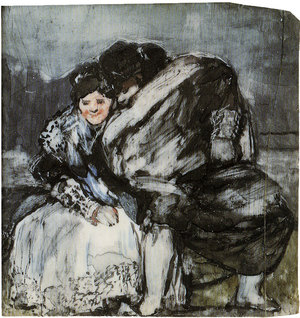
Francisco Goya, A Seated Majo and Maja, Black Carbon on Ivory, Nationalmuseum Stockholm
Something to look for at the MFA’s Goya show (through January 19th, 2015) are the odd small miniatures on ivory that Goya did almost as a set of exercises at the end of his life. There are several of them scattered through the exhibition. Although they were apparently also a feature of the Frick’s late Goya show eight years ago, to me they came as a revelation.
The strangeness of their matter is the first thing to say about them. They are made with black carbon spread over ivory. Goya then dropped water onto the carbon, washing it away into inky wet splotches that the artist then pulled at with his brush and filled in with watercolor. This one became:

And this one:
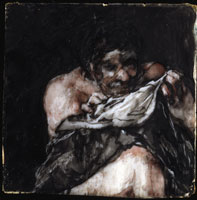
Goya himself was quite pleased with them. He did some forty in the winter of 1824-1825, when he was living, deaf and ill, in voluntary exile from the repressive Spanish monarch among the Spanish expatriate community in Bordeaux. He wrote to a friend about the project:
“last winter I painted on ivory, and I have a collection of nearly forty exercises, but they are original miniatures which I never seen the like of before, because the whole is made up of points and things which look more like Velázquez’ brushwork than that of Mengs.”
His ivories were not of the usual, hyper-detailed kind, painstakingly stippled onto the bony ground, but something altogether more expressive and strange.
In Goya’s hands, the medium is an eerie one, ghostly figures materialize from the greenish depths. Near the opening of the MFA exhibition is an arresting self-portrait drawing of the artist, slumped at a table and beset by a nightmare, a preparatory drawing for the famous etching The Sleep of Reason Produces Monsters.
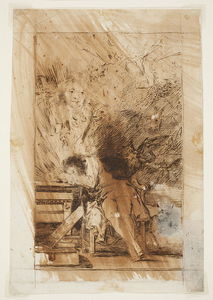
Throughout the show, as throughout Goya’s life, these monstrous visions – human and inhuman – rushed at him. The green ivories, although with the tranquility of all watery evocations, are still full of the restless terror of keeping alive in a mad world. Even one’s clothes belong to vermin and the wind, and one’s face is forever being distorted, washed away, and restored, by the elements, carbon and water, and by the merciless brush of the aged painter.
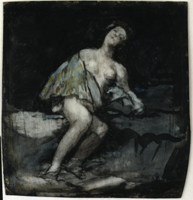
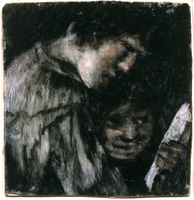
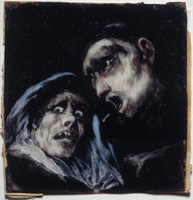
The strangeness of their matter is the first thing to say about them. They are made with black carbon spread over ivory. Goya then dropped water onto the carbon, washing it away into inky wet splotches that the artist then pulled at with his brush and filled in with watercolor. This one became:

Woman with Clothes Blowing in the Wind
And this one:

Man Looking for Fleas in his Shirt
Goya himself was quite pleased with them. He did some forty in the winter of 1824-1825, when he was living, deaf and ill, in voluntary exile from the repressive Spanish monarch among the Spanish expatriate community in Bordeaux. He wrote to a friend about the project:
“last winter I painted on ivory, and I have a collection of nearly forty exercises, but they are original miniatures which I never seen the like of before, because the whole is made up of points and things which look more like Velázquez’ brushwork than that of Mengs.”
His ivories were not of the usual, hyper-detailed kind, painstakingly stippled onto the bony ground, but something altogether more expressive and strange.
In Goya’s hands, the medium is an eerie one, ghostly figures materialize from the greenish depths. Near the opening of the MFA exhibition is an arresting self-portrait drawing of the artist, slumped at a table and beset by a nightmare, a preparatory drawing for the famous etching The Sleep of Reason Produces Monsters.

Throughout the show, as throughout Goya’s life, these monstrous visions – human and inhuman – rushed at him. The green ivories, although with the tranquility of all watery evocations, are still full of the restless terror of keeping alive in a mad world. Even one’s clothes belong to vermin and the wind, and one’s face is forever being distorted, washed away, and restored, by the elements, carbon and water, and by the merciless brush of the aged painter.



